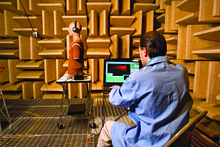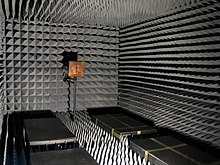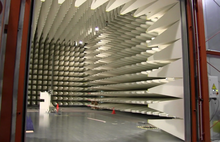
Microwave is a form of electromagnetic radiation with wavelengths ranging from about 30 centimeters to one millimeter corresponding to frequencies between 1 GHz and 300 GHz respectively. Different sources define different frequency ranges as microwaves; the above broad definition includes UHF, SHF and EHF bands. A more common definition in radio-frequency engineering is the range between 1 and 100 GHz. In all cases, microwaves include the entire SHF band at minimum. Frequencies in the microwave range are often referred to by their IEEE radar band designations: S, C, X, Ku, K, or Ka band, or by similar NATO or EU designations.

Electromagnetic compatibility (EMC) is the ability of electrical equipment and systems to function acceptably in their electromagnetic environment, by limiting the unintentional generation, propagation and reception of electromagnetic energy which may cause unwanted effects such as electromagnetic interference (EMI) or even physical damage to operational equipment. The goal of EMC is the correct operation of different equipment in a common electromagnetic environment. It is also the name given to the associated branch of electrical engineering.

A waveguide is a structure that guides waves by restricting the transmission of energy to one direction. Common types of waveguides include acoustic waveguides which direct sound, optical waveguides which direct light, and radio-frequency waveguides which direct electromagnetic waves other than light like radio waves.

Radio waves are a type of electromagnetic radiation with the longest wavelengths in the electromagnetic spectrum, typically with frequencies of 300 gigahertz (GHz) and below. At 300 GHz, the corresponding wavelength is 1mm, which is shorter than the diameter of a grain of rice. At 30 Hz the corresponding wavelength is ~10,000 kilometers, which is longer than the radius of the Earth. Wavelength of a radio wave is inversely proportional to its frequency, because its velocity is constant. Like all electromagnetic waves, radio waves in a vacuum travel at the speed of light, and in the Earth's atmosphere at a slightly slower speed. Radio waves are generated by charged particles undergoing acceleration, such as time-varying electric currents. Naturally occurring radio waves are emitted by lightning and astronomical objects, and are part of the blackbody radiation emitted by all warm objects.

A Faraday cage or Faraday shield is an enclosure used to block electromagnetic fields. A Faraday shield may be formed by a continuous covering of conductive material, or in the case of a Faraday cage, by a mesh of such materials. Faraday cages are named after scientist Michael Faraday, who first constructed one in 1836.

In radio engineering, an antenna or aerial is the interface between radio waves propagating through space and electric currents moving in metal conductors, used with a transmitter or receiver. In transmission, a radio transmitter supplies an electric current to the antenna's terminals, and the antenna radiates the energy from the current as electromagnetic waves. In reception, an antenna intercepts some of the power of a radio wave in order to produce an electric current at its terminals, that is applied to a receiver to be amplified. Antennas are essential components of all radio equipment.
Room acoustics is a subfield of acoustics dealing with the behaviour of sound in enclosed or partially-enclosed spaces. The architectural details of a room influences the behaviour of sound waves within it, with the effects varying by frequency. Acoustic reflection, diffraction, and diffusion can combine to create audible phenomena such as room modes and standing waves at specific frequencies and locations, echos, and unique reverberation patterns.

Reflection is the change in direction of a wavefront at an interface between two different media so that the wavefront returns into the medium from which it originated. Common examples include the reflection of light, sound and water waves. The law of reflection says that for specular reflection the angle at which the wave is incident on the surface equals the angle at which it is reflected.

A resonator is a device or system that exhibits resonance or resonant behavior. That is, it naturally oscillates with greater amplitude at some frequencies, called resonant frequencies, than at other frequencies. The oscillations in a resonator can be either electromagnetic or mechanical. Resonators are used to either generate waves of specific frequencies or to select specific frequencies from a signal. Musical instruments use acoustic resonators that produce sound waves of specific tones. Another example is quartz crystals used in electronic devices such as radio transmitters and quartz watches to produce oscillations of very precise frequency.
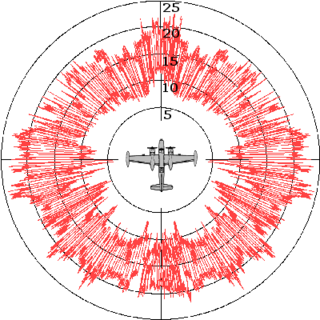
Radar cross-section (RCS), denoted σ, also called radar signature, is a measure of how detectable an object is by radar. A larger RCS indicates that an object is more easily detected.
A reverberation room or reverberation chamber is a room designed to create reverberation, a diffuse or random incidence sound field. Reverberation chambers tend to be large rooms and have very hard exposed surfaces. The change of impedance these surfaces present to incident sound is so large that virtually all of the acoustic energy that hits a surface is reflected back into the room. Arranging the room surfaces to be non-parallel helps inhibit the formation of standing waves - additional acoustic diffusers are often used to create more reflecting surfaces and further encourage even distribution of any particular sound field.
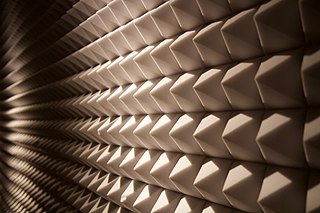
In acoustics, absorption refers to the process by which a material, structure, or object takes in sound energy when sound waves are encountered, as opposed to reflecting the energy. Part of the absorbed energy is transformed into heat and part is transmitted through the absorbing body. The energy transformed into heat is said to have been 'lost'.
Antenna measurement techniques refers to the testing of antennas to ensure that the antenna meets specifications or simply to characterize it. Typical parameters of antennas are gain, bandwidth, radiation pattern, beamwidth, polarization, and impedance.

Acoustic foam is an open celled foam used for acoustic treatment. It attenuates airbone sound waves, reducing their amplitude, for the purposes of noise reduction or noise control. The energy is dissipated as heat. Acoustic foam can be made in several different colors, sizes and thickness.

In materials science, radiation-absorbent material (RAM) is a material which has been specially designed and shaped to absorb incident RF radiation, as effectively as possible, from as many incident directions as possible. The more effective the RAM, the lower the resulting level of reflected RF radiation. Many measurements in electromagnetic compatibility (EMC) and antenna radiation patterns require that spurious signals arising from the test setup, including reflections, are negligible to avoid the risk of causing measurement errors and ambiguities.
Room modes are the collection of resonances that exist in a room when the room is excited by an acoustic source such as a loudspeaker. Most rooms have their fundamental resonances in the 20 Hz to 200 Hz region, each frequency being related to one or more of the room's dimensions or a divisor thereof. These resonances affect the low-frequency low-mid-frequency response of a sound system in the room and are one of the biggest obstacles to accurate sound reproduction.

Loudspeaker measurement is the practice of determining the behaviour of loudspeakers by measuring various aspects of performance. This measurement is especially important because loudspeakers, being transducers, have a higher level of distortion than other audio system components used in playback or sound reinforcement.
A TEM or transverse electromagnetic cell is a type of test chamber used to perform electromagnetic compatibility (EMC) or electromagnetic interference (EMI) testing. It allows for the creation of far field electromagnetic fields in a small enclosed setting, or the detection of electromagnetic fields radiated within the chamber.
An acoustic duct or plane wave tube is a test facility used in acoustics. Anechoic chambers are typically subject to a low frequency limit, governed by the length of the sound absorbing wedges employed to prevent reflections within the chamber. Test and measurement microphone calibration services are often required to be undertaken at frequencies where anechoic chambers cannot be used effectively. In this case, a plane wave acoustic duct with anechoic termination provides a practical alternative.
Ma Dayou or Dah-You Maa was a Chinese acoustical physicist, specializing in various aspects of acoustics, especially sound generation, transmission and absorption. Academician of Chinese Academy of Sciences (CAS), Ma was a research professor at Institute of Acoustics of CAS; Chairman of Chinese National Acoustics Standardization Technical Committee; and Editor-in-Chief of Chinese Journal of Acoustics.



